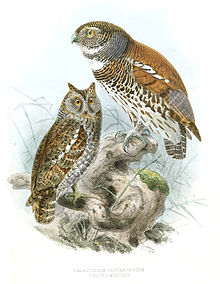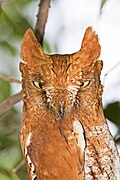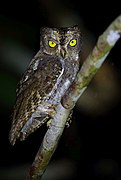Oriental scops owl
| Oriental Scops Owl | |
|---|---|

| |
| Oriental scops owl (left) with a chestnut-backed owlet | |
| Scientific classification | |
| Domain: | Eukaryota |
| Kingdom: | Animalia |
| Phylum: | Chordata |
| Class: | Aves |
| Order: | Strigiformes |
| Family: | Strigidae |
| Genus: | Otus |
| Species: | O. sunia
|
| Binomial name | |
| Otus sunia (Hodgson, 1836)
| |

The oriental scops owl (Otus sunia) is a species of scops owl found in eastern and southern Asia.
Description
This is a small, variable plumaged, yellow eyed owl with ear-tufts which are not always erect. It can be distinguish from the collared scops owl by its whitish scapular stripe, well marked underparts, and lack of pale collar. There are two colour morphs, grey and rufous; intermediate forms also occur. Sexes are similar in appearance. Individuals may freeze with eyes half closed when disturbed. The species has a repeated liquid call sounding like "tuk tok torok".[2]
Distribution and habitat
The species has an extremely wide distribution across eastern and southern Asia, and is found in dry deciduous forests from Russia to Thailand. The owl nests in holes in trees during February–April.[1]
Gallery
References
- ^ a b BirdLife International (2012). "Otus sunia". IUCN Red List of Threatened Species. 2012. Retrieved 26 November 2013.
{{cite journal}}: Invalid|ref=harv(help) - ^ "Oriental Scops-owl (Otus sunia)". Handbook of the Birds of the World. Retrieved 4 April 2018.






